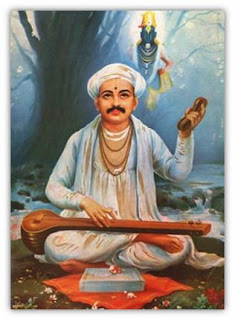We
now come to the last 2 lines of verse 10 which say,
The Benefits gained are:
i.
one attains the glorious state of
Self-hood;
ii.
along with it, he gains all the divine
glories.
iii.
he gains the world of Eswara Himself;
iv.
he regains his state of perfection.
v.
he manifests the eight-fold
supernatural powers.
vi.
he gains all divine opulence without any obstruction.
The Six Phalas of Realization
i) Sarva-Atmatwam: “Self-hood”; this is the highest attainment of
Self-realization or God-realization. It is earned by the Vedantic Sadhaka who
has practised Sravana, Manana, and Nididhyasana to the point of perfecting
them.
He attains the highest
State, namely complete union with the non-dual Brahman. This is the pinnacle of
spiritual attainment. He truly sees the Self in all beings. To him it is not
just a practice anymore, but an actuality in day-to-day life.
ii) Vibhooti: “Divine
glories”. There are 71 Vibhootis of
the Lord described in the Bhagavad Geeta, in Chapter 10. It is also mentioned
that there are an infinite number of manifested Vibhootis, and that Sri Krishna as an Avatara is the foremost Vibhooti.
In the same vein, the God-realised saint is also one of the very special Vibhootis.
iii) Eswaratvam: “Ishwara-hood”; this is earned by the
devout Upasaka who does the worship of the Lord with no selfish desires, but
merely to please the Lord. He attains great purity, and goes to the region of
Brahmaji (Ishwara), which
is termed Brahmaloka.
iv) Siddhi: “state
of perfection”. If one serves an artist, he will more than likely get the
talent of the artist as his Phala.
In the same way, if one
serves some Deity, all of whom come under the rule of Eswara, the Creator, then he will get what that Deity represents.
If he worships Eswara Himself, then
he will receive “Eswara-hood”. And if he devotes himself to the contemplation
of Brahman he will get the fruit of Non-duality or Oneness.
As far as the Brahma Jnani is concerned, having
attained the highest that is to be attained, all other fruits come to him
without his asking.
Parinatam: This
means “manifested”, which implies that these Siddhis are in the realm of Maya.
They do not belong to Brahman. They are part of the Unreal.
Hence, Jnanis give them
little importance; in fact, they are positively a nuisance factor to them as it
attracts the “flies” of curiosity-mongers to them.
Sometimes, however, the
Siddhis are used by saints to alleviate the sufferings of people. There are
Siddhis by which certain cures can be performed. Saints may use powers such as
foretelling an event for protecting a devotee who is likely to face physical
danger, if it helps the person to develop faith in God.
But on no account will
he publicize these Siddhis for the sake of popularity. Also, the siddhis come
to them for a particular purpose and they use them as instrument of Lord and
give no importance to the same once the purpose is fulfilled.
v) Ashtadhaa: “the
eight supernatural powers”. The eight supernatural powers are:
i.
Anima: the
power to assume a very small form.
ii.
Mahima: the
power to become very large, to pervade everything.
iii.
Garima: the
power to make oneself very heavy.
iv.
Laghima: the
power to become very light like a feather.
v.
Praapti: the
power to attain whatever one desires.
vi.
Prakamya: the
ability to go anywhere in the three worlds.
vii.
Ishitvam: the
power to rule over all the three worlds.
viii.
Vashitvam: the
power to control others, to make them follow your lead.
Siddhis
may be earned by the Karma-Upasaka who performs various rites and rituals with
a desire-motive. He attains various heavenly worlds where he can enjoy his
wishes.
vi)Aishwarya: “divine
opulence or excellence”. Traditionally, this is one of the six virtues
possessed by ‘Bhagavan’. The other five are Veerya,
Yashas, Shree, Jnana and Vairagya – i.e. valour, fame,
prosperity, knowledge and dispassion.
Benefit of phala shruti
Suppose, I am a very
worldly person and I pick up this Dakshinamurti Stotra. I read through all
Dakshinamurti is this and that, and I am thinking what all this means to me,
this is all boring. Then I get to this last part that talk about Ashta Siddhi. This
seems interesting to me. I didn‟t get all of the
Dakshinamurti stuff, but I like the powers.
The text however says
that this power is a result of studying this hymn. So that leads me to go back
to the beginning and see what this text is really about.
So, at the very end of
the hymn phala shruti says, if you
study this Dakshinamurti Stotra you will get these eight powers.
Suppose you start
studying the stotra and you study it properly with a teacher and through your
efforts of sravana, manana, nidhidhyasana,
after a long period of time, you may discover that you don’t have these eight
powers; but you have something infinitely more valuable that is
Sarva-Atmatwam: “Self-hood”.
Phala shruti uses a worldly approach to draw you in, but
then the very content of the hymn will redirect you to a higher goal.
With this, we come to the end of this sacred Hymn- Dakshinamurthy Ashtakam or Dakshinamurthy Stotram.
Hari Aum Tatsat
Love.


